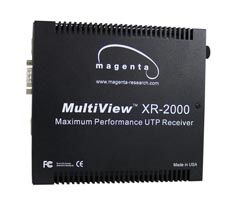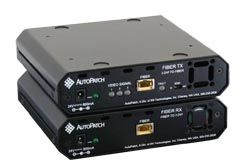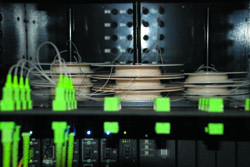- AT&T ran a series of commercials 15 years ago with voiceovers by the actor Tom Selleck extolling the virtues of a broadband fiber-optic network. These included being able to check out of a grocery store with a single ping of the laser pointed at your basket in the checkout line. Today the Magnum man's vision is still a dream because, as Brent Ware, CEO of Tenvera, points out: "The network hasn't been completed."
Tenvera's fiber-based solutions aim to take external fiber networks into whole-premises installations.
Franklin, TN-based Tenvera launched its Fiber-In-The-Premises (FITP) solution last year. With a range of products designed to take external fiber networks one step farther into whole-premises installation, Tenvera says that only a fiber solution can give users of AV content the bandwidth they will need to keep up with future developments in technology."The current copper infrastructure will be incapable of handling all the consumer electronics products and services scheduled for deployment over the next 24 months," Ware speculated. "Without a fiber backbone in your home or office, your network is going to slow to a crawl or lock up. Even with the new media servers being offered, if you try to run more than three plasmas or LCDs off the server they slow down dramatically. The same is true with the IPTV revolution that is just around the corner."

Extron's 6400 fiber optic matrix switcher
Cost Analysis
Fiber-optic cables allow digital information to flow at a rate over 100 times faster than so-called 'broadband' copper cable. Yet while an extensive fiber-optic network was laid under our streets by telecom companies like AT&T in the 1980s and '90s, our buildings were-and are-flooded with structured cabling, otherwise known as Cat-5/6 or twisted pair. It is this 'category' cable which now carries audio, video, and data signals around the majority of commercial AV environments, and which continues to be the focus of most integrators' attention when it comes to designing a commercial AV system.The main reason for this is cost. twisted pair cabling first caught the eye of integrators because it was so much cheaper than RGB video. Many commentators would argue that fiber needs to do the same to twisted pair-or at least get on level terms-before it can compete. As Andy Fliss, vice president of sales and marketing at Aurora Multimedia, puts it, "RGB is going to cost you $2.50 per foot, Cat-5 is going to be a dime. When you're looking at 200 feet of cable, that adds up. And 10 meters of terminated fiber is going to cost $300. That's on the expensive side."

Magenta Research's Multiview XR-2000
On the eve of this year's InfoComm show, Aurora, which specializes in IP-based controllers and image processors, announced it was merging with RTcom, which develops switchers for fiber. Fliss describes the arrangement as "a technology merger" that benefits both parties, rather than a deal to simply increase sales. What characterizes both companies is their commitment to a digital future. Yet Fliss is pragmatic about near-term trends in the industry. "If you have two integrators bidding on a job, and it's Cat-5 doing RGB versus fiber, then the guy quoting Cat-5 is going to win the job, and the guy who quoted fiber isn't going to quote fiber next time," Fliss said. "Integrators want to make a profit today, not tomorrow. Fiber may be the future-proof option, but that argument only carries weight if it's part of the end-user requirement."
Going The Distance
Proponents of fiber point out that it offers more than merely superior bandwidth. John Lopinto, president and CEO of Communications Specialties, emphasizes the ability of this company's Pure Digital Fiberlink solution to carry signals at far greater distances than those possible on twisted pair networks. "Products like our 7220 Series will send VGA and stereo audio signals over a single fiber for distances of more than 30 kilometers," Lopinto said, "without a repeater, without going back to baseband, without compression, without scaling-in fact, without any signal manipulation at all."
Not every project requires those sorts of distances to be covered, however. Magenta Research has a foot in both camps with its Infinea transmitter/receiver range, which is capable of extending the reach of DVI video, stereo audio, and RS-232 control data in two different ways: over a single strand of fiber for up to 10km (6.2 miles), or over Cat-6 for short to medium distances up to 600 feet.
"Multiple Infinea modules can be daisychained together, so you can go across a campus over fiber, then into a facility over UTP, then back out again over fiber if you need to," explained Randy Young, Magenta's marketing and business development director. But Young also points to a recent project that saw Infinea units installed into the New York Times headquarters to connect a digital signage network spanning 20 floors of the building, with 10 screens on each floor-and UTP cable was used throughout.
At InfoComm last month, Magenta debuted the latest addition to its MultiView range of UTP solutions, which is capable of sending UXGA video over Cat-5/6 at distances of up to 2,000 feet. As Young points out, that's enough to do some pretty big projects, including the majority of retail stores, sports arenas, airports, and convention centers.

AutoPatch's Digital Generation DVI to fiber
Lee Dodson, vice president of marketing at Extron Electronics, echoes the sentiment. "Integration companies are built to address the jobs at hand, and there isn't always the manpower available to look at new technologies," he said. "The typical integrator doesn't have involvement with fiber until they come up against a job that requires it. As manufacturers, the onus is on us to increase their awareness. That's where we come in with our education programs, and also where events like InfoComm come in with theirs."
Dodson sees parallels between the contemporary fear of fiber and the suspicion with which twisted pair solutions themselves were once regarded. "If you recall, twisted pair was also slow getting off the ground. People looked at these tiny little connectors and wondered how they would get the same quality they were used to getting out of big BNC coax connectors. But the industry overcame those fears, and now twisted pair is seen as being a mature technology."
So mature, in fact, that the sheer variety of distribution options offered by manufacturers has become another compelling reason to stick with twisted pair solutions. "There are way more options in terms of hubs and switches and chaining receivers-different ways to go from X number of sources to Y number of destinations," Young said. "The offering is a lot more adaptable, and it's also more difficult to do all that in the fiber world than it is with UTP cable."
Which is not to say that manufacturers will not continue to raise the bar in terms of what is possible in the distribution and management of fiber-borne signals. Extron used InfoComm to debut the Fiber Matrix 6400, a modular fiber-optic matrix switcher for complete, end-to-end digital AV signal transmission and routing over fiber.
"The Fiber Matrix 6400 was specifically designed for facilities requiring a highly robust, dependable switching system using a fiber-optic infrastructure to distribute high-resolution video signals," Dodson said. "We've built specific features into this matrix switcher that expedite AV system integration and ensure uninterrupted, continuous 24/7 operations. But we also introduced more matrix switchers using Twisted Pair technology, and we see strong sales in both segments of the market."
Conflict Resolution
If there is one thing likely to drive a shift toward fiber, it is the seemingly relentless move toward ever-higher video resolutions, and the subsequent demands on network bandwidth.











